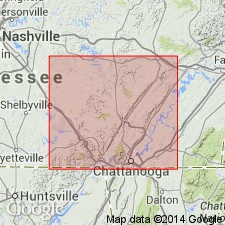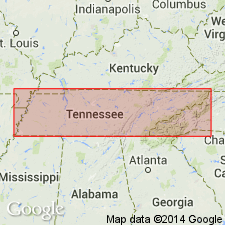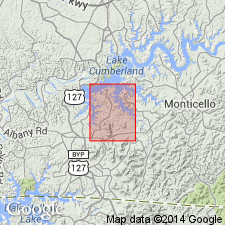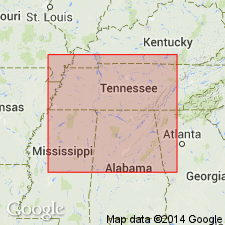
- Usage in publication:
-
- Monteagle formation*
- Modifications:
-
- First used
- Dominant lithology:
-
- Limestone
- AAPG geologic province:
-
- Cincinnati arch
Summary:
Name is credited to a 1959 unpublished Ph.D. thesis at Northwestern University by P.R. Vail. Description is sketchy. Mentioned only as a carbonate unit between the St. Louis limestone and the Big Clifty sandstone in the Cumberland Plateau of TN.
Source: GNU records (USGS DDS-6; Reston GNULEX).

- Usage in publication:
-
- Monteagle Limestone
- Modifications:
-
- Named
- AAPG geologic province:
-
- Cincinnati arch
Summary:
Monteagle described as white and light gray fine- to coarse-grained thin to very thick bedded fossiliferous and oolitic limestone, 150 to 300 ft thick. 200 ft thick at type section, which is here designated along Hwy 41 in Marion Co. Unit is subdivided into six divisions (I to VI). Subdivision V is La Follette Member (new). Overlies St. Louis Limestone and underlies Hartselle Formation. Age is Late Mississippian.
Source: GNU records (USGS DDS-6; Reston GNULEX).

- Usage in publication:
-
- Monteagle Limestone*
- Modifications:
-
- Revised
- Areal extent
- Overview
- AAPG geologic province:
-
- Cincinnati arch
Summary:
Monteagle Limestone is mapped and described in Cumberland City quad, southern KY, where is as much as 280 ft thick. Includes Ste. Genevieve Limestone Member (reduced in rank), about 80 ft thick, in lower part and unnamed limestone member, 90 to 200 ft thick, in upper part. Overlies St. Louis Limestone. Underlies Hartselle Sandstone. Ste. Genevieve Limestone is not recognized at type section of Monteagle in TN and serves as a member only in this area.
Source: GNU records (USGS DDS-6; Reston GNULEX).

- Usage in publication:
-
- Monteagle Limestone
- Modifications:
-
- Overview
- AAPG geologic province:
-
- Cincinnati arch
Summary:
Monteagle consists of shoaling upward parasequences of shallow-water carbonates. A complete parasequence includes (ascending) burrowed, echinoderm/bryozoan pack- and grainstones; cross-bedded, oolitic pack- and grainstones; and dolomitic and lime mudstones. Unit is juxtaposed with the Pride Mountain Shale in northeast AL, considered by some workers to be a facies change. The Pride Mountain, however, does not include any Genevievian rocks, while the Monteagle is both Genevievian and Gasperian. Environment of deposition interpreted as ramp rather than a steep-margin platform.
Source: GNU records (USGS DDS-6; Reston GNULEX).
For more information, please contact Nancy Stamm, Geologic Names Committee Secretary.
Asterisk (*) indicates published by U.S. Geological Survey authors.
"No current usage" (†) implies that a name has been abandoned or has fallen into disuse. Former usage and, if known, replacement name given in parentheses ( ).
Slash (/) indicates name conflicts with nomenclatural guidelines (CSN, 1933; ACSN, 1961, 1970; NACSN, 1983, 2005, 2021). May be explained within brackets ([ ]).

